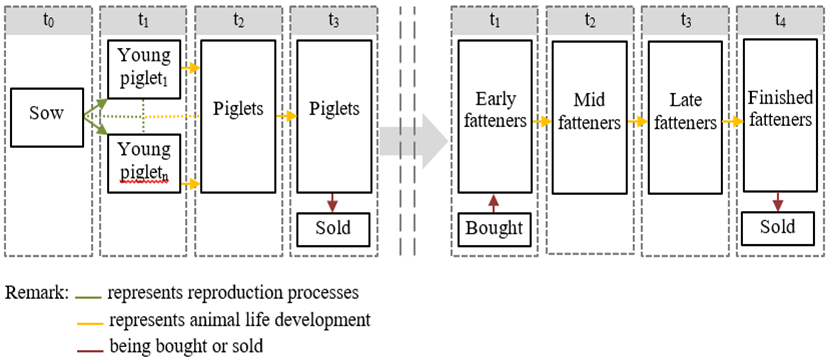Pig Module
The pig module, similar to the cattle module, is closely linked with the general herd module. The herd dynamics of the pig module are shown in Figure 1.
 : Figure 1: Pig Module Management Decisions.
: Source: Own Illustration.
: Figure 1: Pig Module Management Decisions.
: Source: Own Illustration.
The piglet production process starts with the production of young piglets born which are raised to sows as shown in the following equation:
$$iftheni.sows "%farmBranchSows%"=="on"
newPiglets_(t_n(tCur(t),nCur),m) $ sum(feedRegime,actHerds("sows","",feedRegime,t,m)) ..
v_herdStart("youngPiglets","",t,nCur,m)
=e= sum(actHerds("sows","",feedRegime,t,m),
v_herdSize("sows","",feedRegime,t,nCur,m) * p_OCoeff("sows","youngPiglet","",t))/card(m);
$$endif.sows
Each sow produces on average 26.7 young piglets per year in the default parameterisation. After one month young piglets become weaners and remain 2 months within the herd before they are sold or transferred to the fattener branch. Labour and feed requirements are chosen according to a growing period of 41 days and a weight gain from 8 to 30 kg. The feeding-, stable- and labour requirements of the piglet production branch are steered by the sows and piglets herd size.
The fattener farm branch distinguishes between four different stages of fatteners to account for different feeding and excretion values during the production process. Feeding levels and excretion values are connected via the set feedregime. This set allows to adapt feeding patterns, for instance to adjust nutrient output in response to legislatively given fertiliser restrictions. For a more thorough explanation of the feeding options, please refer to the pig feeds module in section 2.2.2. The piglets bought in a month are immediately transferred into early fatteners and to the next fattening stage after a month until they become fatteners and are sold as fattened pigs. Each stage lasts for one month. The weight development during the fattening process is assumed from 28 to 118kg live weight.
As mentioned in the general herd module description, equations such as herd balance herdsBal_ and herd size, herdSize_ are used for the herd dynamic in the pig module. The following model code shows the elements of the herd used in the farm branch for sows.
$$iftheni.sows "%farmBranchSows%" == "on"
herds_from_herds("piglets","youngPiglets","") = yes;
bought_to_herds("youngSows","","sows") = yes;
actHerds("piglets","",feedRegimePigs,t,m) = yes;
actHerds("sows","",feedRegimePigs,t,m) = yes;
actHerds("youngPiglets","",feedRegimePigs,t,m) = yes;
actHerds("youngSows","",feedRegimePigs,t,m) = yes;
$$endif.sows
The statements below show the elements of the herd used in the farm branch for fatteners:
$iftheni.pigHerd %pigHerd% == true
$$iftheni.fattners "%farmBranchFattners%" == "on"
actHerds("PigFattened","",feedRegimePigs,t,m) = yes;
actHerds("Fattners","",feedRegimePigs,t,m) = yes;
actHerds("earlyFattners","",feedRegimePigs,t,m) = yes;
actHerds("midFattners","",feedRegimePigs,t,m) = yes;
actHerds("lateFattners","",feedRegimePigs,t,m) = yes;
actHerds("pigletsBought","",feedRegimePigs,t,m) = yes;
bought_to_herds("pigletsBought","","earlyFattners") = yes;
herds_from_herds("midfattners","earlyfattners","") = yes;
herds_from_herds("lateFattners","midFattners","") = yes;
herds_from_herds("Fattners","lateFattners","") = yes;
$$endif.fattners
Feeding
The feeding requirements for the piglet production branch differentiate between sows with the attached young piglets and the piglets after separation from the sows. Requirements are set for energy, crude protein, lysin, phosphorus feed and dry matter. Further, minimum and maximum requirements are set for certain feeds in order to reflect realistic feeding patterns. For example, a minimum requirement for oil in the feed intake is assumed to assure a correct viscosity.
The fattening branch distinguishes between four fattening stages to provide the option of nitrogen and phosphorus reduced feeding (N/P). It includes the stages earlyFattners, midFattners, and lateFattners. Three feeding regimes are applicable, which are: normal feed, reduced N/P feed and highly reduced N/P feed. The primary differences between the feeding schemes are the adjustments of daily nutrient requirements depending on the stage a fattening pig is currently in. For instance, with the normal feed there are only two different feeding requirements; a daily requirement for the weight range from 28-40 kg which is in the early fattening phase and a daily requirement from 40-118 kg which assumes daily feed requirements in the mid, late and finishing fattening stage. In contrast, the N/P reduced feeding phase differentiates between daily nutrient requirements for the weight ranges 28-40 kg, 40-70 kg and 70-118 kg. Thus, all stages require different daily nutrient requirements. In accordance with the piglet production branch, the fattening branch also imposes maximal and minimal values for certain products to account for digestibility, correct feeding textures and mineral provision.
The requirements are used to determine the optimal feeding mix shown in the equation reqPigs_. Hence, it can be seen which feeding products are used by which herd type at a certain time. The equation feedSourcePig_ determines the source of feed, i.e. whether it is purchased or produced on farm.
reqPigs_(possHerds,feedAttr,feedRegime,t_n(tCur(t),nCur),m) $ ( sum(actHerds(herds,"",feedRegime,t,m),1)
$ p_feedReqPig%l%(possHerds,feedRegime,feedAttr)
$ (not (sameas(possherds,"pigletsBought") or sameas(possherds,"youngSows")
or sameas(possherds,"youngPiglets")))) ..
v_herdSize(possHerds,"",feedRegime,t,nCur,m) * p_feedReqPig(possHerds,feedRegime,feedAttr)
=L= sum(feedspig $ sum(sameas(feedsPig,curInputs),1), v_feedingPig(possherds,feedsPig,feedRegime,t,nCur,m) * p_feedAttrPig(feedsPig,feedAttr));
feedSourcePig_(feedspig,t_n(tCur(t),nCur)) $ (sum(actHerds(herds,"",feedRegime,t,m),1) $ sum(sameas(feedsPig,curInputs),1)) ..
v_feedOwnPig(feedspig,t,nCur) $ sum(sameas(curProds,feedspig),1)
+ v_feedPurchPig(feedspig,t,nCur)
=E= sum((possherds,feedRegime,m)
$ [ (not ( sameas(possherds,"pigletsBought") or sameas(possherds,"youngSows")
or sameas(possherds,"youngPiglets")))
$ sum(actHerds(possHerds,"",feedRegime,t,m),1)],
v_feedingPig(possherds,feedsPig,feedRegime,t,nCur,m));
The upper and lower bound for the feeding mix are then determined by feedTotPig_, feedMaxPig_, feedMinPig_ (not additionally shown here) which allows certain flexibility in the feeding mix.
However, for the fatteners the feeding mix is fixed for different feeding regimes to precisely reproduce empirically found feeding ratios.
Pig Specific Manure Excretion
With regard to excretion of animals, relevant equations and variables can be found in the general_herd_module.gms. v_manQuantM is the monthly volume in cubic meter of manure produced. As a default, liquid manure is considered in the model. The monthly manure excretion, v_manQuantM, is computed in the following equation:
manQuantM_(curManChain(manChain),t_n(tCur,nCur),m) $ (not sameas(curManChain,"LiquidBiogas")) ..
v_manQuantM(manChain,tCur,nCur,m)
=e=
sum( actherds(possHerds,breeds,feedRegime,tCur,m) $ (manChain_herd(curManChain,possHerds) $ p_prodLength(possherds,breeds)),
p_manQuantMonth(possHerds,curManChain) * ( 1 - 1 $ sameas(feedRegime,"fullGraz")
- 0.5 $ sameas(feedRegime,"partGraz"))
* v_herdSize(possHerds,breeds,feedRegime,tCur,nCur,m));
Furthermore, the monthly excretion of nutrients, NTAN (total ammonia nitrogen), Norg (organic nitrogen) and P (phosphorus) is calculated, multiplying v_herdsize and p_nut2ManMonth. For cows, the excretion rate depends on animal category and feeding regime. Corresponding parameters can be found in coeffgen\manure.gms (not shown here).